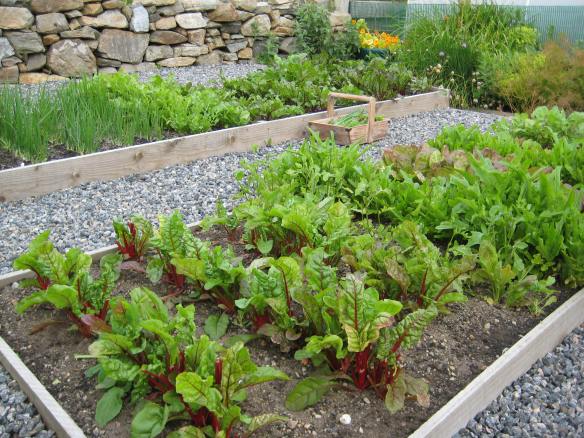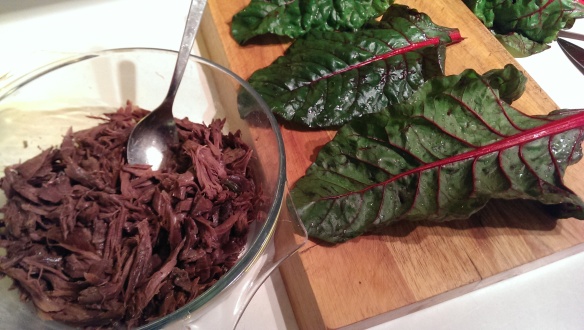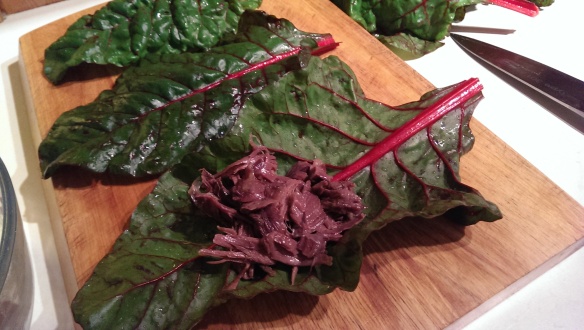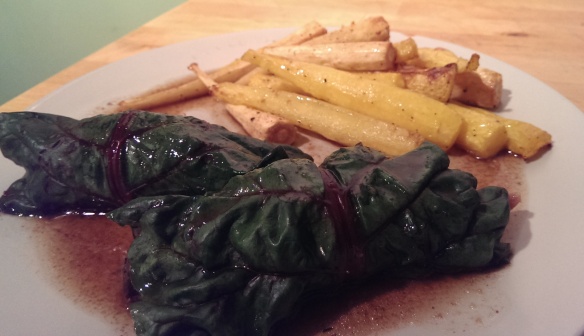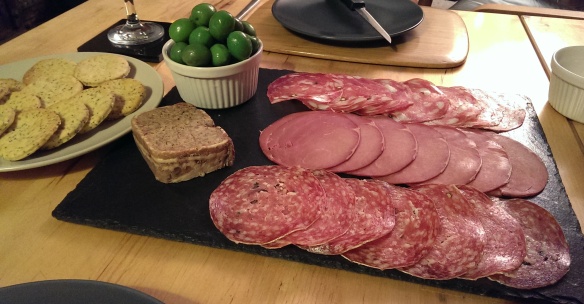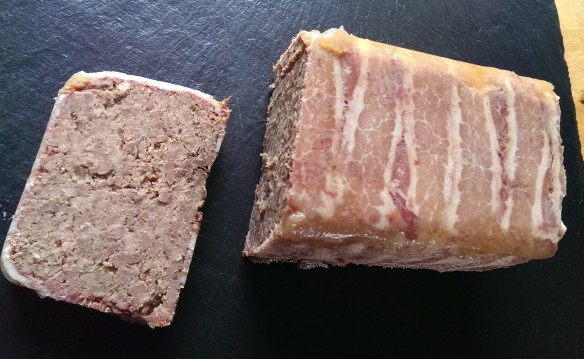This recipe uses one of the best cheap cuts from our stockpile of local venison – shanks, combining these with my favourite and infallible vegetable crop of this year, Swiss chard. The cooking marinade has a hefty glug of port and serves as a simple sauce, being further enriched with aromatic star anise, juniper berries and herbs. I say sauce. I’m not sure what it should technically be called – it is not a gravy (a thickened sauce), and probably not a jus (unthickened gravy type affair). Sauce. A thin one. That will suffice, for me at least.
As ever, posts and blogging interactions have been restricted by my commitments over the last few weeks. Hopefully, with Christmas only a week away, I can start to think less about work and building and more about a bit of festive cheer – maybe even produce a festive post? Well, that might be pushing it a bit. Bah humbug, we will see…
Swiss chard – a stoic vegetable
My Swiss chard crop has been the star of my veg bed greens this year. Despite perpetual harvesting and hacking, gales and pelting horizontal rain, it persisted, unblackened and magnificently upright compared with my very ragged and battered leeks.
I say persisted. A raging storm last week meant I had to be pragmatic and accept the blackening blast would be the end of the chard crop for the year. Now it can only be described as charred chard.
The storm was pretty fierce, there was a lot of flash, bang and wallop as the weather fronts rolled in from the Atlantic, gusts over 80 mph causing the occasional lurch and shudder of our old croft house. This peaked with a magnificent thunderstorm, the crescendo as it approached accompanied by hail stones battering against the back of the house (and bedroom window), the tumultuous auditory assault and accompanying spectacular lightning passing overhead about 0400 hrs, rattling the windows and leaving both of our telephone lines fried in its wake.
There was absolutely no chance of getting a wink of sleep, particularly with our baying hounds joining in with the racket to ‘enhance’ the cacophony. I couldn’t resist opening the curtains to stare at the spectacle as the storm approached. I was rewarded by a gargantuan flash that left me blinded for a few seconds. Although overhead, the thunder could barely be heard for the roar of the wind, hail, dogs, rattling downpipes, etc. We rushed around the house, switching off all the appliances – we have had circuits fried in phones, printers and the cooker in the last few years. Incredibly, though the power supply wavered, it stayed on, as did our broadband. Until later in the day when, just as I was approaching a critical work deadline, the broadband signal inexplicably disappeared, to be followed by the power an hour later. Power was restored within an hour, broadband the next day. It took a week to have one phone line fixed and we are still waiting on the fault on the other to be repaired – nearly 2 weeks later.
Ride the lightning
I have always been fascinated by storm watching, as a child I was transfixed by thunder and lightning, often only to be disappointed by the brevity and relative meekness of our UK storms (although we have discovered they are more frequent and sustained in the Hebrides). Not so when I moved to Portugal and I could enjoy the light show of autumn storms, fork lightning cracking the sky, illuminating the hills surrounding the village. I delighted in Equatorial storms in Ecuador, predictable weather patterns accompanied by biblical cloudbursts. Most recently, on the Slovakian border with Ukraine, I became completely mesmerised, watching an eerily quiet 3 hour luminescent display of heat lightning while sipping beer on my hotel terrace on a still, balmy evening. The frequent staccato lightning bolts branched and flickered, repeatedly incising the sky, like cracks running across a pane of glass.
Storms are, of course, to be respected and revered, and can only be enjoyed when you are not in danger. Sadly, the hurricane of 2005 that took 5 members of the same family on South Uist will remain a bleak reminder that one can never be complacent about forecasts. That night changed people’s perspective and sensitivity towards extreme weather across these exposed islands.
The wind speed during last week’s storm isn’t at all unusual for the Uists and such storms, indeed it is going to be the same again tonight. Occasionally some more ferocious storms occur, maybe only once each winter. Last week, the storm pulled tiles off 3 neighbouring properties and we were lucky not to sustain damage. We are relatively protected from storms by low-lying hills around the house on the side of the prevailing south-west wind, but northerlies like the storm last week have the potential to do most damage to our house.
There have been one or two occasions when the wind has reached hurricane speed that I did become slightly alarmed. One particular night comes to mind in winter 2009 when wind speeds exceeded 100 mph. Inevitably, the power went off, then we heard the alarming sound of creaking and a slumping sound. This was a down pipe shaking loose, pulling with it a clump of render 4 x 4 m off the back of our house. This storm lifted the roof off a building on St Kilda where wind speeds reached in excess on 120 mph.
Hurricane Bawbag
While these storms can be alarming, the now infamous ‘Hurricane Bawbag’ was particularly memorable. This name coined on Twitter and was adopted thereafter, notably on the cover of one Red Top next morning, complete with the image of a wind turbine ablaze in Ayrshire.

It was quite an appropriate moniker for this scunner of a storm in Scotland, we couldn’t possibly have just called it Bob, Fred or Frieda in a regular Hurricane-naming way. I note the meaning of bawbag is not provided in reference to the event on Wikipedia but can be found here for the curious. During this hurricane on 8 December 2011, the rest of Scotland got the flavour of wind speeds we experience here during severe winter storms. Although we did lose power at home, plus 4 gates and a chimney cowl that night, unfortunately, I was not home but ironically in the eye of the storm for a meeting in Edinburgh.
Enduring a storm in a landscape devoid of trees and a few low, dispersed buildings in a rural landscape is an entirely different prospect to experiencing a hurricane in our capital city. Scaffolding poles, roof tiles, trees and even flying rubbish became a serious hazard while myself and my colleagues staggered through the city centre, trying to avoid getting hit by detritus and being blown into the path of traffic along the way. The proposed festive outing to drink gluhwein at the outdoor continental market in Princes Street was most definitely cancelled.
Here, in the grip of another, more moderate gale tonight, it is comforting to know it’s unlikely to be ‘Bawbag II’, although with gusts of 80 mph, power could again be disrupted. A good night then to remind myself of the chard and other veg growing in the garden in mid summer: It won’t be long before it comes around again…
Port-soaked venison shanks wrapped in Swiss chard
The venison shanks had to be decanted from one of our freezers to accommodate the surprise early arrival of our Christmas turkey from my crofting neighbour. It was also surprisingly large. We were offered a smaller bird, but the caveat was I would have to go round and dispatch it myself. I declined. Earlier in the year, I could see these free range birds wandering about casually on the croft from our house and hear their calls on still nights. Our bird is a completely different shape from commercially farmed birds, being naturally proportioned, without those implant-style breasts that farmed birds sport. I look forward to comparing it with last year’s bronze turkey.
The venison shanks were slow cooked in a stock-based marinade for about 5 hours by which time the meat is very tender and falls from the bone and can be flaked, removing the most gelatinous components of the tendons and ligaments in which these tough muscle fibres are enmeshed. It is then ready for rolling in chard leaves which are steamed. Lettuce leaves such as little gem can also be used as a substitute for chard, and lamb shanks for venison.
The venison-filled chard parcels were served simply, with a little of the rich and aromatic cooking sauce and some carrots and parsnips from the garden.
Pre-heat oven to 150C
Ingredients
2 venison shanks
2 tbsp. olive oil
2 garlic cloves, crushed.
1 onion, chopped
100 ml of port
1 star anise
8 juniper berries, crushed
bunch of thyme springs
1 bay leaf
1.5 litres of game or chicken stock
salt and pepper to taste
Method
- Brown the venison shanks in olive oil in a large casserole dish, then add the rest of the ingredients to cover the shanks, bring to a simmer.
- Put the lid on and place the casserole in the oven for 4-5 hours, checking occasionally to ensure there is enough stock marinade to cover the shanks. Top up with water/stock as necessary.
- Remove the shanks and allow to cool slightly before pulling the tender muscle meat away from the now gelatinous tendons, ligaments and sinews. The meat will have already fallen off the bone.
- Mix a small amount of the cooking sauce with the meat and roll a generous large spoonful in each chard leaf, securing with a cocktail stick, if required. Steam the parcels for 5 minutes and serve with some of the cooking sauce and vegetables of your choice. I suggest 2 parcels per person.

